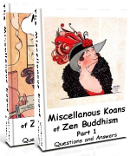History of Buddhism - Gotama's Story
Free ebooks!
Zen Riddle #3 - stars :
Put out the stars in the sky.
Here's the answer....(Show/Hide)
Want more riddles? Choose one!
#4-boat #5-ghost #7-counting mumonkan
Zen Riddle #3 - stars :
Put out the stars in the sky.
Here's the answer....(Show/Hide)
Want more riddles? Choose one!
#4-boat #5-ghost #7-counting mumonkan
A brief history of Buddhism is all about Siddharta Gotama, son of a Shakya farmer (king) in North-east Indian. Gotama became an ascetic and a "muni", a sage.
Later on the devotees of the Shakyamuni Gotama called him "Buddha", the Enlightened One.A slow start
Unlike similar sages of this time and area the muni Gotama, became known as "Shakya-muni", was not forgotten and did not vanished after three or four generations.
On the contrary, his followers remembered and retold the history of Buddha Shakyamuni and his story.
His teachings were constantly changed and decorated with more and more devotional details.
This pious remembering of Buddha began at the foothills of the Himalayas in the late fifth century BC.
 A Buddhist Mantra
A Buddhist Mantra
The movement had dropped: the Arayan cast-system, the traditional gods and goddesses, the chanting of vedic scriptures, but many traditional beliefs were kept. Therefore in the long run Buddhism like Jainism became an unorthodox Vedic schools.
Although in this way connected to ancient India Buddhism was just a footnote in 60,000 years of human history in India.
Peace - the bottom line of Buddhism
For a long time Buddhism was a minor religious school in Northern India, that remembered the peaceful way of its founder:
- The Buddha had given up his life as a wealthy farmer to become an ascetic.
- After some years he'd stopped the ascetic fighting against his body.
- Instead he taught meditation as a silent detachment from desire and suffering.
But it wasn't attractive for the still fighting Indo-Aryan warriors in 4th century BC Northern India.
Very few Aryan tribes converted to Buddhism until Alexander the Great invaded the Ganges valley in the 4th century BC.
Not surprisingly, Alexander and his generals preferred to deal with the less violent Buddhist rulers.
Greco-Buddhist interaction
Greek philosophers who accompanied Alexander's army became fascinated with Buddhism.
Even a brief history of Buddhism can't ignore the impact of three hundred years of Greco-Buddhist interaction.
 Buddhist Sutra
Buddhist Sutra
Buddhist ideas were picked up in Greek philosophy, especially in the sceptic and cynic schools.
One example: Buddhist settlements in Alexandria, that lasted until Roman times is known from antique sources.
But Greek thinking influenced the brief history of Buddhism in India as well.
The most obvious result was the creation of a Buddha idol. First he looked like a wandering Greek God.
Later the Buddha sat down in countless Yoga-variations of Lotus position.
Similarly important in the history of Buddhism were the meetings and Greek style discourses, the councils about the Buddha's teachings.
Sectarian factions of Buddhism
During the councils the leader of the Buddhist movement several times tried to sort out conflicting interpretations of the Buddha's teachings, the sutras.
But the councils only resulted in continuous defections of sects and sub sects.
Every group insisted on maintaining the true interpretation of the Buddha's sutras and his code of behaviour.
These splits happened along the lines of two main Buddhist factions
- Theravada (the ancient truth) and
- Mahayana (the middle way),
But the driving force that brought Buddhism through the centuries wasn't religious or philosophical discourse.
The closeness of Buddhism to regional politics outside India made the movement successful.
Until today Buddhist monks are taking sides in political conflicts.
In the 20th century it happened in China and Japan; today it's still happening in in Tibet, Burma, Sri Lanka and Thailand.
This trait of Buddhism is quiet old. Let's go back to 3rd century BC to see how it began.
Buddhism in Indian politics - the successful centuries
 History of Buddhism in India
History of Buddhism in India
In the 2nd century BC, protected by the Mauryan King Ashoka, Buddhism became the dominant religion in India and spread all over Asia.
Buddhism was Ashoka's alternative to the traditional Brahmin culture.
- Ashoka encouraged the Greco-Buddhist interaction,
- converted to Buddhism and
- made it a monastic religion with tight behavioural codes (Vinaya).
- Ashoka sent out missionaries who preached Buddhism from the Mediterranean to Mongolia and South-East Asia.
- The missionaries took up local beliefs and created indigenous versions of Buddhism.

Buddhist Koan
Wherever and whenever this political support vanished Buddhism also vanished.
Briefly the history of Buddhism changed after the Mauryan empire broke down in the late 2nd century BC.
The empire was succeeded by several dynasties and rulers.
In Northern India most of them tolerated, or even favoured Buddhist monasteries and monks.
North Indian Buddhism became the dominant intellectual and cultural form of philosophy and religion in Asia.
Countless Indian missionaries went abroad and Buddhists from everywhere came to India.
Many of them studied at the North Indian Buddhist University of Nalanda.
Buddhism in Indian politics - the decline
During the middle ages Mongolian Kings and, later, Islamic forces invaded Northern India and introduced the invaders' beliefs. Buddhism became less and less influential.

Buddhist Saying
Buddhism slowly retreated to the South of India.
The last remains of Buddhism in India was a shrine in Nangapattinam on the South-East coast of Tamil Nadu.
It was destroyed by Jesuit missionaries in the 1860s.
So much about the brief history of Buddhism in India. But Buddhism went on elsewhere.
During the centuries of decline in India the center of Buddhist culture shifted to South Asia and China.
Buddhism in China - a dialogue of civilisations
Taoists and later Buddhist monks in China transcribed and translated thousands of sanscrit scriptures since 1st. century CE.
They sometimes used Taoist terms and pattern for sanscrit words.
The sanscrit term "dhayana" (meditation) was used in China for centuries.
Finally many of the ancient document of Buddhism survived only in their Chinese transliteration.
At the end of the Tang dynastie in 9th century government suppression of foreign religions nearly ended Buddhism in China.
It survived by changing "dhayana" into "Channa".
Later in 10th century Buddhism was revived in China as "Chan".
Buddhism China, therefore focused on meditation on 'Chan' or channa, the sanscrit "dhayana".
Much later (13th century) when Japanese monks came to study Buddhism in China in the , they read the Chinese characters for 'Chan' as 'Zen'.
Later Zen Buddhism was practised by Japan's ruling class, but it became soon forgotten.

Tea Ceremony
From the mid-20th century Japanese masters introduced Zen in Western countries.
Its practises became imitations of Japanese culture, rituals and behaviour, the most rigid spirituality in Buddhism history.
Buddhism History
Return to Home Page from Brief history of Buddhism






